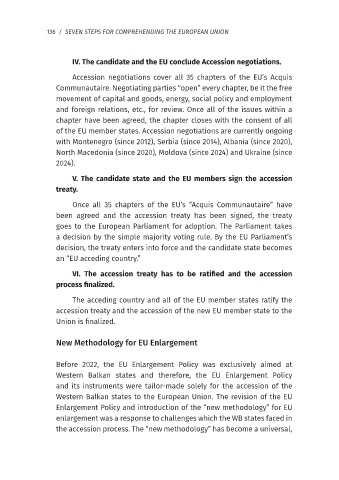Page 137 - SEVEN STEPS for COMPREHENDING the EUROPEAN UNION
P. 137
136 / SEVEN STEPS FOR COMPREHENDING THE EUROPEAN UNION
IV. The candidate and the EU conclude Accession negotiations.
Accession negotiations cover all 35 chapters of the EU’s Acquis
Communautaire. Negotiating parties “open” every chapter, be it the free
movement of capital and goods, energy, social policy and employment
and foreign relations, etc., for review. Once all of the issues within a
chapter have been agreed, the chapter closes with the consent of all
of the EU member states. Accession negotiations are currently ongoing
with Montenegro (since 2012), Serbia (since 2014), Albania (since 2020),
North Macedonia (since 2020), Moldova (since 2024) and Ukraine (since
2024).
V. The candidate state and the EU members sign the accession
treaty.
Once all 35 chapters of the EU’s “Acquis Communautaire” have
been agreed and the accession treaty has been signed, the treaty
goes to the European Parliament for adoption. The Parliament takes
a decision by the simple majority voting rule. By the EU Parliament’s
decision, the treaty enters into force and the candidate state becomes
an “EU acceding country.”
VI. The accession treaty has to be ratified and the accession
process finalized.
The acceding country and all of the EU member states ratify the
accession treaty and the accession of the new EU member state to the
Union is finalized.
New Methodology for EU Enlargement
Before 2022, the EU Enlargement Policy was exclusively aimed at
Western Balkan states and therefore, the EU Enlargement Policy
and its instruments were tailor-made solely for the accession of the
Western Balkan states to the European Union. The revision of the EU
Enlargement Policy and introduction of the “new methodology” for EU
enlargement was a response to challenges which the WB states faced in
the accession process. The “new methodology” has become a universal,

